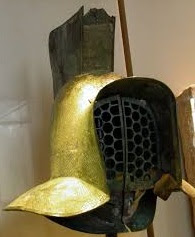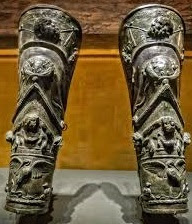 | A new exhibition has opened at the Archaeological Museum Hamburg, "Gladiators - Heroes of the Colosseum." The first documented gladiator fights took place in Rome in 264 BC. Descendants of a deceased person had three pairs of slaves compete against each other in the honor of the dearly departed. Typically, the fight would happen in a marketplace. These private battles of nobility became increasingly popular among citizens of ancient Rome. Under Augustus (63 BC - 14 AD), games were allowed only during a few specific days of the year. |  |
 | Gladiators were not always prisoners or slaves. Gladiator schools ensured a supply of highly trained fighters and many free citizens also joined. The games offered a chance for the most successful warriors to earn redemption, wealth and freedom. The typical schedule of a fight day started around noon, with executions of criminals sentenced to death. Afterward, circus acts would sometimes take the stage. After a few additional fights, the gladiators were presented as the main act. Women also fought against each other. This was officially banned in the year 200. |
 | A gladiator was an armed combatant who entertained audiences in the Roman Republic and Roman Empire. Most were slaves, socially marginalized, and segregated even in death. The origin of gladiatorial combat is thought to be the 3rd century BC, and thereafter it rapidly became an essential feature of social life in the Roman world. Its popularity led to ever more lavish and costly games. The games lasted for nearly a thousand years, peaking between the 1st century BC and the 2nd century AD. The games declined during the early 5th century after the adoption of Christianity. |  The average age of those killed in the arena was around 28. Few gladiators survived more than ten matches. |
 | The person who presided over the games was called the editor. He could be the emperor, a senator, or other political figure and made the final decision about the fate of the gladiators in the arena. To make sure the loser wasn’t pretending to be dead, an attendant dressed as Mercury would touch him with a hot iron wand. If they were still alive, another attendant, dressed as Charon, would hit him with a mallet. |  |
 | If a gladiator repeatedly survived the arena and lived long enough to retire, they were given a symbolic wooden training sword, or rudis, as a token of their freedom. Even when they had won their freedom, the lucrative life of the gladiator still appealed: rudiarii were gladiators who had won their freedom but chose to remain fighting in the arena. |  |
 Gladius, an early ancient Roman sword | There were many types of gladiators and each had different weapons. It was usual to pair off combatants with widely different, but more or less equivalent, equipment. Studies have shown that gladiators fought to strict rules and barefooted. During combat musicians performed and altered tempo to match that of the combat. |  Roman Gladiator Dagger |
 Four-pointed dagger |  Roman soldiers were taught to deploy the gladius horizontally, piercing the enemy's ribs and penetrating vital organs. | Roman iron gladiator trident. |
 |  |  Gladiator Arm Guard |  Greaves (leg protectors) and dagger discovered at Pompeii's gladiator barracks. |
 |  Pair of bronze greaves from the Gladiators' Barracks in Pompeii. |  |  Helmet of a murmillo. |

No comments:
Post a Comment